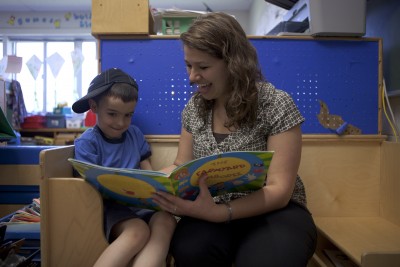
There is a very simple reason why, for nearly 20 years, Neag professor of curriculum and instruction Dr. Mary Anne Doyle has been a passionate advocate for and the driving force behind UConn’s participation in Reading Recovery, a program aimed at dramatically improving the reading skills of at-risk first-graders. “It just works phenomenally well,” says Doyle. “And it’s about so much more than reading.”
The funding, part of a $46 million U.S. Department of Education grant to be shared among 19 partner schools, will enable Doyle to continue reaching out to, and reducing tuition costs for, Connecticut schools electing to implement this early intervention and participate in the program. In-service teachers are nominated by their districts and receive Reading Recovery certification through the Neag School of Education at UConn, the only university in the state that offers it.
Created more than 30 years ago by University of Auckland professor Marie Clay, Reading Recovery is a one-to-one program aimed at helping first-graders with extreme difficulty learning to read and write. They are typically in the bottom 20 percent of their classes. Students work in 30-minute sessions, with a specially trained Reading Recovery instructor, in a curriculum that emphasizes reading and writing development.
Reading Recovery teachers assess their students’ progress daily and document measurable results in a very short period of time.
After a full series of lessons, taking anywhere from 12 to 20 weeks, most students reach grade-level standard. “For those students who don’t,” says Doyle, “the lessons serve as a period of diagnostic teaching that can be the basis for long-term planning. Both of these outcomes are positive.”
Reading Recovery children who exit the program at grade level continue to improve their literacy skills and perform within an average range of class performance without ongoing remediation or special support. “Considering where these students start,” Doyle adds, “these results are remarkable and have profound implications for schools and districts implementing response-to-intervention methods while striving to achieve yearly progress in literacy.”
Early intervention is Reading Recovery’s reason for being. “For too long,” says Doyle, “educators insisted that all we needed to do was give children the ‘gift of time’ and their reading skills would evolve and improve.” But, she adds, that was a grave disservice to students. “When they’re not catching on,” she says, “they’re trying to make connections and do it for themselves, and they’re very confused about it. What they need is someone helping them immediately.”
The program’s successes support that point of view. Reading Recovery can claim more than 2 million first-graders nationwide, across all socioeconomic levels, who have benefited from the program. Nearly 80 percent achieved grade-level reading skill within the 20-week period. In October of this year, the National Center on Response to Intervention (NCRTI) gave Reading Recovery’s screening tool, An Observation Survey of Early Literary Achievement, its highest possible rating for scientific rigor.
The NCRTI called the survey “valid, reliable and evidence-based.”
In addition, in 2007, the Institute of Education Sciences “What Works Clearinghouse” gave Reading Recovery the highest rating possible for research evidence relating to its effect on alphabetic skills and general reading achievement, and the second-highest rating for its effect on fluency and comprehension.
But even with all the accolades, Doyle is still working as hard as ever to promote the Reading Recovery approach to school districts around Connecticut. Several cities and towns have been with the program since the mid-1990s; but in a time of serious budget-cutting and uncertainty about education funding from the state, some districts have had to put a hold on implementing this intervention and sending teachers for training.
Doyle demonstrates to superintendents and boards of education that while Reading Recovery has its costs, it can also be a cost-saving move by reducing retention and lowering remediation rates and special education numbers. “I tell the districts that Reading Recovery always makes a difference for every child who participates,” Doyle says, “regardless of whether he or she achieves grade level skill. It also helps identify other needs the child might have and kick-starts the ways those needs can be met once the program ends.”
Though she doesn’t say so specifically, Doyle could easily tell school districts to “accept no substitutes.” Reading Recovery is a trademarked program, administered through Ohio State University, and while it has been modified, based on research and annual evaluations, it is still disseminated and implemented according to guidelines designed and established by Clay. School districts sometimes attempt to mimic its one-to-one reading instruction without having teachers receive the extensive training that Reading Recovery provides.
Doyle emphatically says they will not be as effective. “This program is not a bandwagon,” she says. “It’s not a little bag of tricks that teachers can pick up at a conference. Graduate-level study means you read theory, you analyze deeply, you problem-solve. This is about teaching children to read. It is hard work.”
A hallmark of Reading Recovery is intense, year-long training for school-based teachers, which entails graduate coursework offered by the Neag School, and ongoing professional development offered six times a year thereafter. In the final analysis, the power of the program rests in knowledgeable teachers. Thus, Reading Recovery is an investment in teachers who are well-prepared to have an impact on both learners and programs. They acquire the professional knowledge and skills to make a profound difference for young learners in need of an intensive, early intervention in literacy to assist their colleagues with curricular and instructional “issues.”
Doyle confirms Reading Recovery, a school-university partnership, makes a difference for children and their parents as well as for teachers and schools. The i3 (Investing in Innovation) grant, awarded by DOE to support the scaling up of Reading Recovery, is giving the Neag School’s Reading Recovery Training Center and our Connecticut schools an exciting and unprecedented opportunity.
 Facebook
Facebook
 Twitter
Twitter
 LinkedIn
LinkedIn
